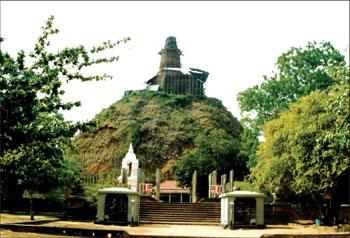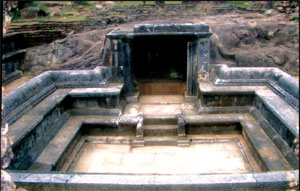Sanitation and healthcare in ancient Sri Lanka
Prof. W I Siriweera
Sanitary and healthcare facilities in Sri Lanka varied according to
the status of social groups. The royalty, nobility and the elite
priesthood lived relatively comfortable lives and enjoyed reasonably
good sanitary facilities.
|

Abhayagiriya |
The extant evidence of porcelain ware, palace complexes, baths and
pleasure gardens used by the royalty give an indication of living
conditions of the royalty and the nobility. The remains of the major
monastic complexes and ponds, wells, underground terracotta pipes,
drains, toilets and septic tanks attached to them indicate that Buddhist
priests in major monasteries enjoyed a relatively high level of sanitary
facilities.
On the contrary, various references in Pali and Sinhala literary
texts point to the hardships faced by the peasants and ordinary people.
The living standards and conditions and sanitary facilities available to
them and to the priests in temples in remote villages were rudimentary
when compared to those of the upper strata of society.
Nevertheless, there is no doubt that regular bathing, brushing teeth,
cutting long hair and nails, cleaning and sweeping the habitats and
surroundings mentioned in texts such as Mahavagga, Samantapasadika and
Sikhavalanda Vinisa in relation to Buddhist priests were relevant to all
categories of lay society as well irrespective of their social standing.
It is due to developments of such habits and practices that Robert
Knox was able to observe in the latter part of the seventeenth century,
that the Sinhalese were an extremely clean people.
The Caraka Samhita as well as the Susruta Samhita pay particular
attention to physical exercises. According to these texts a self-loving
person should do physical exercises in all seasons to maintain lightness
of the body, activeness and youthfulness.

A hot water bathing pond |

The remains of an ancient pond |

A washroom inside a cave used by monks in the past |

An ancient medical spa |
The Kandavuru Sirita written during the Dambadeni period indicates
that the king too, was expected to do the same. The monks were supposed
to perambulate in monastic compounds early in the morning. Thus the
efficacy of physical exercise was well recognized throughout history.
The Arthasastra of Kautilya written during the fourth century B.C.,
was known and studied in Sri Lanka. While stipulating the ideal system
of statecraft, this work refers to ideal rules and regulations to be
adopted in health and sanitation management in cities.
Accordingly, dumping garbage, allowing garbage to pile up, leaving
room for water to gather in one place, defecation in public places,
disposing of dead bodies of such pets as cats in streets were strictly
prohibited.
Similarly, the cremation of dead bodies in places not earmarked
specifically for such purposes was prohibited. Offenders were to be
punished by fining; the fines varying according to the gravity of the
offence.
Whether such strict regulations were enforced in all Indian cities is
doubtful. Their enforcement in Sri Lankan cities is even more doubtful.
But what is important to note is that the concept of sanitation, hygiene
and cleanliness of cities were recognized as priorities in both
countries.
The Pandukabhaya legend in the Mahavamsa refers to the establishment
of villages in the periphery of the city for five hundred Candala
scavengers, two hundred of whom were entrusted with cleaning the sewers
of the city, one hundred and fifty entrusted with removing dead bodies
from the city and one hundred and fifty assigned to maintain graveyards.
These figures and the period to which they can be applied leave room
for debate. Nevertheless it is certain that at least when the Mahavamsa
was written in the sixth century A.D., healthcare in the capital city
was well organized.
The remains of the ancient cities of Anuradhapura, Sigiriya and
Polonnaruwa, too, clearly demonstrate the attention paid to the
environment, sanitary conditions and healthcare. Water management in the
environs during monsoon rains, the supply of water to the cities, the
sedimentation and filtering techniques in ponds and canals, the
discharge of used water out of the cities as well as garbage and refuse
disposal had undoubtedly been arranged according to a set plan in each
of these cities. |



